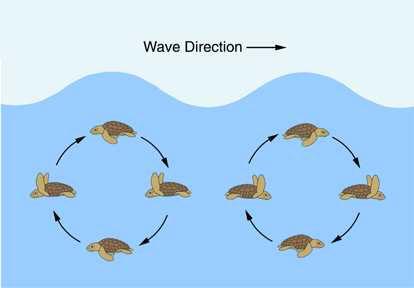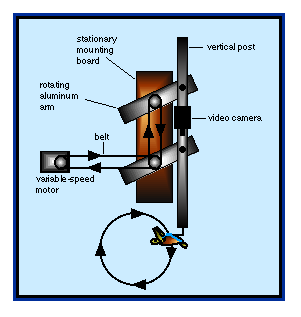Objects suspended in the water near the surface of the ocean describe a circular or orbital pattern of movement as waves propagate through the sea. The same is true for hatchling turtles -- but for the turtle, the precise sequence of accelerations that will be experienced depends upon the direction that the turtle is facing relative to the direction of wave movement. For example, hatchlings facing into waves will be accelerated upward, then backward, then downward, and then forward with each wave (see diagram on left below). In contrast, a turtle swimming in the same direction that waves move will experience a different sequence of accelerations: upward, forward, downward, and backward (see diagram on right below).

To determine if hatchlings can detect wave direction by monitoring the sequence of accelerations that occur under water as waves propagate, we designed and constructed the machine shown below, which we call a "wave motion simulator". The wave simulator reproduced in air the circular movements that a hatchling normally encounters while swimming beneath small oceanic waves.

How is it possible to test hatchling sea turtles in air instead of in water?
The key is that, under natural conditions, the signal that tells young turtles that they have entered the ocean is the absence of contact with the substrate. Hatchling turtles are positively buoyant; thus, they float up when they enter the water. As soon as a hatchling is no longer touching the ground, it begins to swim. Swimming behavior can also be elicited if a hatchling is placed into a small cloth harness and suspended in air. Under these conditions, a hatchling will "swim" in air, apparently unaware that it is not in the ocean. We took advantage of this unusual swimming behavior to investigate how turtles detect wave direction.
To watch a short video clip of hatchlings swimming in air, click here. Be sure to notice how the hatchling periodically stops swimming and lifts its head to breathe -- despite being in air the entire time!
Results: Thus, hatchlings can evidently determine the direction of wave movement by monitoring the sequence of accelerations that occur as waves move through the ocean. Such an ability is presumably useful for animals that enter the ocean at night and must guide themselves seaward in almost total darkness. Although sea turtles are the only animals known to detect wave direction in this way, a similar ability may exist in other migratory ocean animals such as fishes.

